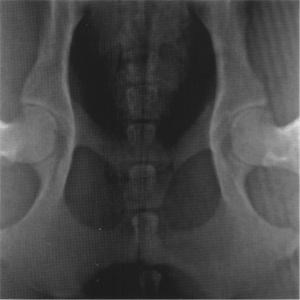What is pyometra?
Pyometra is an accumulation of pus in the uterus. Toxic products form and make the bitch very sick.
How do I know if my dog has pyometra?
If the cervix is open pus drains from the vagina and can be seen on the skin or hair under the tail or on bedding and furniture.
If the cervix is closed, the trapped pus distends the uterus and abdomen. The bacteria in the pus release toxins into the circulation. The dog goes off her food, vomits or passes diarrhoea, drinks a lot of water and becomes very depressed.
How is it treated?
Pyometra is an emergency. Surgery to remove the uterus and ovaries ensures complete recovery. If not treated toxins cause organ damage. If the cervix is closed the uterus may rupture and spill into the abdominal cavity. Either of these is rapidly fatal. Intravenous fluids and antibiotics before and after surgery reverse the toxicity and control residual infection.
When does it occur?
Pyometra is most common in older bitches after many years of oestrus cycles without pregnancy. Occasionally younger bitches are affected.
Pyometra occurs about 1-2 months after oestrus.
How is it diagnosed?
A non-desexed female dog that is very ill , drinking a lot of water, and has a vaginal discharge or an enlarged abdomen could have pyometra. They also have a high white blood cell count and serum globulin level. Toxins reduce the ability of the kidneys to concentrate the urine.
An ultrasound examination identifies an enlarged uterus and differentiates pyometra from pregnancy.
Why does my dog have pyometra?
Hormonal changes cause pyometra. After a bitch is on heat or in season (oestrus), progesterone levels stay high for 8-10 weeks, thickening the lining of the uterus in preparation for pregnancy. If pregnancy does not occur for several oestrus cycles, the lining continues to thicken and cysts form in it. The thickened, cystic lining secretes fluid creating an ideal environment for bacterial growth. High progesterone levels also inhibit contraction of uterine muscles preventing expulsion of the fluid.
Drugs containing progesterone and/or oestrogen also predispose bitches to pyometra.
How do bacteria get into the uterus?
The cervix is the gateway to the uterus. It remains tightly closed except during oestrus. When the cervix is open during oestrus vaginal bacteria can enter the uterus easily. If the uterus is normal, bacteria won’t survive. However, when the uterine wall is thickened and weak, conditions are perfect for bacterial growth.


 rst for fleas and ticks in many years because of the high rainfall.
rst for fleas and ticks in many years because of the high rainfall. 

 Ear infections are very common in dogs, especially breeds with long or hair ear canals like Poodles, Cocker Spaniels and Golden Retrievers. Often they are the first or only sign of doggy hayfever (also known as atopy). Sometimes the infection is secondary to a grass seed.
Ear infections are very common in dogs, especially breeds with long or hair ear canals like Poodles, Cocker Spaniels and Golden Retrievers. Often they are the first or only sign of doggy hayfever (also known as atopy). Sometimes the infection is secondary to a grass seed. We have seen an upsurge in dogs with sun induced skin cancers in the last month or so. Most of these are on the bellies of Staffies or Jack Russells that love to lie on their backs in the sun.These cancers can be difficult to remove completely if they are not caught early and will recur if the sunbaking continues.
We have seen an upsurge in dogs with sun induced skin cancers in the last month or so. Most of these are on the bellies of Staffies or Jack Russells that love to lie on their backs in the sun.These cancers can be difficult to remove completely if they are not caught early and will recur if the sunbaking continues. Dogs with Geriatric Vestibular Disease have a head tilt, walk in circles, fall to one side, appear disoriented and are reluctant to stand up. Some also have flicking eye movements, known as nystagmus. Many dogs feel nauseous and vomit.
Dogs with Geriatric Vestibular Disease have a head tilt, walk in circles, fall to one side, appear disoriented and are reluctant to stand up. Some also have flicking eye movements, known as nystagmus. Many dogs feel nauseous and vomit. Heart murmurs are quite common in older dogs, especially in small breeds. They are due to problems with the valves between the chambers of the heart.
Heart murmurs are quite common in older dogs, especially in small breeds. They are due to problems with the valves between the chambers of the heart.